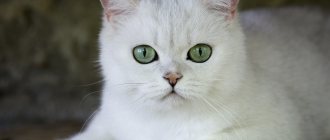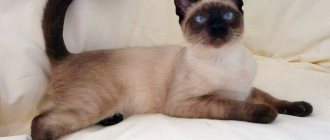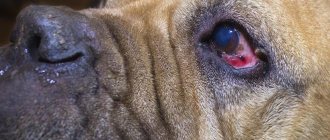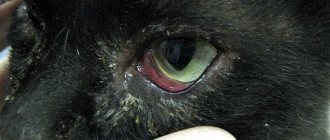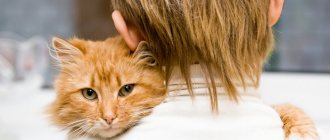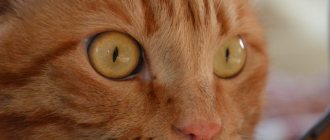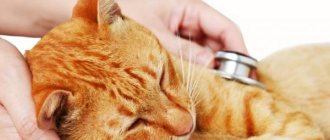When owners watch kittens' eye color change, it is always interesting to predict what the permanent shade will be. In this regard, there are opinions about the possibility of correcting it with special nutrition or the relationship with the color of the coat pigment. In reality, such assumptions have no scientific basis, the future color is laid down at the genetic level at the moment of conception, and the process of “recoloring” itself is associated primarily with the development of the visual organs.
Development of kittens (+ table)
Development of kittens (+ table)
Kittens are born small (weight 60-115 g, average body length 12 cm) and completely helpless, blind and deaf; all they can do is find their mother’s nipples, sleep and suck.
They cannot even get rid of excrement products on their own; to do this, the cat licks the appropriate places for them and eats their feces. However, they grow and develop quickly, and watching this process is a fascinating activity! Already a few days after birth, kittens begin to “knead” their mother’s belly with their paws, stimulating the secretion of milk (I wonder who taught them this?) They try to crawl, helping themselves with their front paws. At the age of seven days, a kitten can already crawl several tens of centimeters. At approximately 10-14 days of age, kittens' eyes begin to open.
. At this age, the eye color of all kittens is blue; it will change to the final adult color (“rebloom”) later, at the age of 3 months. At the same time, the ear canal opens and the kittens begin to hear.
In the third week
of life, kittens begin to erupt milk teeth (later they will be replaced by permanent ones).
Their vision and hearing improve and they begin to explore the world around them. By the end of the first month of life, they can sit, move quite confidently and learn to play with each other. At one month of age, kittens become interested in trying foods other than their mother's milk.
Content Features
Plush pets, like any cats, require proper care and proper nutrition. Before bringing home a Scottish kitten, the owner must purchase the following supplies for it:
- a small tray with low sides;
- bedding made from natural materials;
- scratching post;
- hypoallergenic toy.
It is necessary to begin raising an animal from the first days of the appearance of this fluffy ball in the house. Scottish cats are considered ideal pets. They easily make contact with all family members, having a special sympathy for small household members. Cats prefer sleep to active games. They are very attached to their owner and love to sit on his lap for hours.
The pet's sleeping place should not be located near a window or on the aisle. The Scots love warmth and comfort. They also do not like long walks in open areas. This breed is prone to being a homebody. For cats, various structures, such as stairs or shelves, are of great interest.
Scottish cats eat premium or super-premium food. They are highly digestible and rich in vitamins and minerals essential for cats. Natural foods are also suitable for Scots: lean meat, cereals, boiled fish and vegetables. The diet of kittens should be varied. And at the same time, babies should not be overfed. An overweight animal begins to move little and subsequently acquires a number of dangerous diseases.
Cats with short hair are brushed no more than once a week. This procedure is carried out using special brushes and combs. Bathe your pet as needed, and keep your ears and eyes clean every day. Scottish kittens are characterized by increased lacrimation, so the owner needs to stock up on special drops from the pet store.
The following video will tell you how to choose a healthy Scottish kitten.
Why do kittens' eyes change color?
Eye color in cats depends on the amount of coloring pigment. Therefore, the reason for the change in eye color is the accumulation of melanin in the eyeball during the development of the visual organs. However, blue color is a recessive trait, which is why eyes of this shade are very rare.
At the moment of embryo formation, there are approximately 3 dozen pigment centers in the body of the future kitten. Migrating throughout the animal’s body during its development, the bulk of them settle in the fur. At the same time, the eyes account for only a small proportion of pigments, which continue to accumulate after the kitten is born. In the process of their accumulation, a change in the color of the kitten’s eyes occurs.
Why do eyes change color?
Several factors influence the change process.
The reason is melanin
The amount of dye depends on the breed of animal.
This pigment is formed in the fetus during intrauterine development. Most of it goes into the hair follicles, the organs of vision remain light blue or gray.
Kittens, as representatives of the class of mammals, are born with insufficiently formed organs. Cat cubs are born blind.
After a few days, the eyelids open slightly; the final opening occurs after the first week of life.
Newborn animals have little melanin in the iris. During the process of eye formation, a certain amount of pigment accumulates and a color change occurs.
Genetics
Heredity is responsible for the final shade and the speed of its manifestation.
Genes carry data on the amount of pigment, its color, speed of manifestation, and at what age the process begins.
The amount of melanin in the iris determines its color: with a large amount, the tone of the iris is copper-brown, with a deficiency - yellow, green, blue.
Physiological features affecting the color of the iris
The color of the animal depends on the accumulation of melanin pigment. There is more of it in the fur, and less in the eye area. The absence of a coloring component is indicated by the blueness of the organs of vision. The phenomenon is typical for albinos. However, the transformation of the visual organs is also associated with age-related changes.
Up to two weeks, the color of the cub's eyes is masked by a grayish film. In a growing kitten, pigment accumulates, so the color of the iris changes. The following eye colors are typical for cats:
- bluish;
- green;
- yellow;
- orange (copper).
The main tone of the kitten's eye color is formed by 17 weeks. It is at this age that a breeder should purchase a breeding animal.
Breed differences
The color of the iris is a sign of a purebred cat. For some breeds, eye color does not matter. Others - with atypical coloring - are excluded from breeding. Blue eyes are characteristic of albinos of different breeds. A distinctive feature of the British is the orange iris. For black solids, any color except green is acceptable. The standard for Siamese and Thai cats is blue.
Eye diseases
Changes in eye color are a pathological symptom and occur as a result of the following ailments:
- cataract;
- glaucoma;
- uveitis
Cataract
Characterized by clouding of the lens. Pathology develops as a complication of infectious diseases or occurs in older individuals during age-related changes. The eye takes on a dull gray or bluish tint. The animal's vision deteriorates.
Cataract
Glaucoma
The reason is increased intraocular pressure. The pupil is constantly dilated. Local opacification is observed. Small blood vessels burst, causing the white of the eye to take on a reddish tint. In addition to external manifestations, the cat’s health deteriorates sharply.
Glaucoma
Uveitis
The pupil becomes matte. The conjunctiva turns red. The eye sphere increases. Both eyes are affected and the animal goes blind.
Uveitis
Changes in the pigmentation of the organs of vision can be a normal physiological process, a developmental abnormality, or a consequence of a disease. An alarming symptom is clouding of the pupil or cornea. The pet needs veterinary care.
We invite you to join our Zen channel and group on VKontakte or Odnoklassniki, where new articles for pet owners are published.
Similar articles:
- My cat has a nosebleed - what should I do?
- Inflammation of the lower lip in a cat
- Clear nasal discharge in cats
When does eye color change occur?
Each cat breed changes eye color at certain times. Most often it occurs between 2 weeks and 12 months after the eyes begin to open. A kitten's eye color changes gradually. Two weeks after birth, the eyes are covered with a cloudy film. Because of this, they appear to have a gray tint. And only then the shade becomes more pronounced. From this moment you can approximately determine what eye color will be. However, you cannot be sure of this, since the range of shades is very large - from a gray-blue tint to brown. Therefore, those who get a purebred kitten and want it to have a particular eye color most often adopt it at the age of 4 months.
It is worth noting that if the kitten initially had yellow eyes, then this color becomes brighter - amber, copper or golden. That is, brown eyes can never acquire a blue tint.
At what age does eye color become permanent?
According to the physiological characteristics of the structures of the human body, the pigment is produced by special cells - melanocytes. Their activity does not begin immediately after the baby is born, but after some time. Thus, the pigment accumulates gradually, day after day. This is why some parents note that the baby’s eye color changes almost daily. On average, obvious changes in the color of the iris begin from the age of three months.
Most often, the final eye color of a baby can be judged already at six months of age. However, there are cases when a change in the amount of pigment can last up to two or even three years. Sometimes complete heterochromia occurs in the body - uneven distribution of pigment. This causes the baby's eyes to turn different colors.
Partial heterochromia affects the color of different parts of the iris. At the same time, small differences in eye color are not very noticeable. However, if heterochromia occurs, it is necessary to show the child to an ophthalmologist in order not to encounter undesirable consequences of this disorder. It is impossible to predict in advance what color the baby’s eyes will be.
Rare colors
Amber is a new and not yet approved species. Externally similar to golden, but more subdued. The peculiarity is the presence of single black hairs located nearby.
Doubts about color are caused by the fact that dark stripes or dots are visible against a warm background, and cats, not at the genetic level, can be either black or red. For now, Amber is recognized in one of the felinological organizations for the Kuril Bobtail breed.
Kittens with the rare fawn color are a gift for many breeders. It is a variation of lilac, but a very light shade. The color of the nose is beige and pink, as are the pads on the paws. Eyes amber or copper.
This is a monochromatic color, the pigment in the hairs is evenly distributed. The quality of British wool should not suffer from bleaching, despite its apparent softness.
Cinnamon or cinnamon is a derivative of the chocolate color. The color is solid and uniform, without blemishes or marks. The shade is delicate, slightly muted. The color of the nose of the cinnamon is brownish-pink.
There are two types of shade: yellow and red. It is layered on top of the base brown. The paw pads are colored similarly to the nose.
Popular misconceptions about changing eye color in cats
On many forums where inexperienced breeders begin to advise cat lovers on how to care for them, incorrect information comes across. Popular misconceptions about eye changes in cats include the following facts :
- All kittens, without exception, initially have a blue-gray tint to their eyes.
- There is a relationship between fur color and iris color.
- The color of the iris depends on the kitten's diet.
Each of these theories has no scientific proof. But despite this, breeders are taking measures to breed cats with exactly the eye color that is becoming the standard.
Dichromatic eyes
In this case, the pet has two shades of the iris on one eye. Sometimes it looks like a colored ring around the pupil of a different shade, or the eye is divided into two different colored fragments.
Important! Judges at professional cat shows consider this a disadvantage, but amateurs consider it a cute and attractive feature. Sometimes mirror dichromacy occurs in both eyes at once.
Common Misconceptions
On the Internet you can find many myths and misconceptions related to the process of “repainting” cat eyes. Here are just a few of them:
- All newborn kittens must have bright blue eyes. Some believe that deviations from this “norm” threaten serious pathologies. In practice, it happens that kittens’ eyes can be colored in different gradations of gray and blue colors... And all this is the norm. If the iris of a recently born kitten is not blue, this is not a pathology!
- There is a common misconception about the correlation between coat color and eye color. This opinion is partly true. But only for representatives of certain breeds whose coat color was “tied” to the color of the iris during a long and difficult selection process. It’s just that in their case, the eye color can actually be anything, and this is also not considered a deviation.
- Some breeders are truly convinced that eye color depends on... diet. But this “theory” is absolutely not confirmed either by science or by practical observations of breeders. It is known, however, that frequent feeding of fish can cause a cat’s fur to noticeably darken, but even in this case, its eyes will not change color.
We invite you to read: What types of discharge can occur in cats after giving birth and when treatment is required
Content
If you have decided to bring a white Scottish kitten into your home, you need to know everything about proper care.
- You should always ventilate the room, as tartans cannot tolerate stuffiness.
- You need to remember about bathing. It should take place at least 3-4 times a year using a special shampoo at a comfortable water temperature (up to 40 degrees Celsius). After the procedure, you need to gently blot your pet with a towel without rubbing it, use a hairdryer to dry it if the animal is not afraid of the sound of the device, and, of course, brush it. Kittens especially do not like water, so in extreme cases you can buy a special dry shampoo or choose a spray.
- Cats must be brushed at least 2 times a week. To do this, you need to use a brush with rare teeth so as not to injure your pet.
- No matter how fashionable it may be to take pets to salons, it is not recommended to cut these cats, as their fur protects them from hypothermia.
- In sedentary cats who do not leave the house at all, their claws need to be treated. You can purchase a special nail clipper and use it every two weeks. It is better to take care of buying a scratching post and get the kittens accustomed to it, observing where they like to sharpen their claws.
- Kittens' eyes can become very watery - this is due to the special structure of the nasolacrimal ducts. You should regularly wash your pet's eyes with gauze, moistening it with water.
- Ears should always be cleaned with a cotton swab soaked in vegetable oil. You can also purchase special solutions for treating ears at your veterinary pharmacy.
- Toilet. It is easy to accustom a kitten to the tray by simply placing it in the required place after sleeping and feeding. Scottish dogs quickly get accustomed to this and rarely cause trouble for their owners.
- Short-faced cats often have problems with their teeth and gums, so every week it is necessary to hygienically brush their teeth with a cat brush. You can use water or buy a special paste for pets.
Caring for a white Scot will never be a burden
From childhood, you need to pay attention to hygiene, nutrition and care of your pet. In this case, a healthy pet will always be in a great mood and will become a best friend for many years.
For more information about Scottish cats, see the following video.
What do they say about cats with blue eyes?
Cat eyes have four primary colors – blue, green, yellow and copper. What eye color your pet will have depends on genetic characteristics. If he is predisposed to the presence of a large number of melanocytes, then his eyes will be dark, if there is little of this pigment, they will be light.
There are no blue eyes as such. If a cat has eyes of this shade, then its body does not produce enough pigments. We simply mistake the reflection in their transparent part for the blueness of the eyes. However, scientists have not established a connection between a cat’s health and its life expectancy.
What color can the eyes be? Factors influencing the final eye color of a cat
- Blue.
A cat without melanin has a blue color reflected in its iris. Although eye color is generally independent of fur color, white breeds are more likely to have blue eyes. Breeds: Siamese, Burmese, Thai, Persian, Himalayan, Foreign White, Turkish Angora, some British Blue, Scottish Fold, Ojos Azules.
- Green.
If kittens accumulate little melanin pigment, green eyes appear. The longhaired chinchilla (Persian chinchilla) is known for its emerald green eyes with black edges. The Tonkinese cat has a sea green color. The Egyptian Mau has gooseberry-like eyes.
The Russian Blue cat has the most incredible rich green hue.
Russian blue cat
- Yellow or orange.
Dark breeds are more often found with this shade. It is characteristic of large wild animals - lions and tigers. For this reason, the tiger's eye gemstone got its name. Colors are typical for cats of solid colors, tabby, tortoiseshell, as well as ginger cats of any breed. Here you can note Burmese, Abessinian, Bombay. British Blue Shorthairs have bright yellow eyes. Any deviations from the norm are rejected at exhibitions.
British blue cat
- Brown eyes.
Cats with brown eyes are not actually brown. Most often it is copper. It can also be seen as a darker shade of copper or orange. It happens because there is a lot of melanin in the iris of cats.
- Different colors.
Heterochromia is a mutation in which the right and left eyes are different shades.
This occurs when the white gene blocks the distribution and concentration of pigment in the iris. Heterochromia can be acquired as a result of illness, injury or medication. The deviation is most often found in epistatic white cats, in which one eye is blue and the other is of any other shade.
Heterochromia in cats
- Dichromatic eyes.
Dichromatic is used to describe two colors in one eye. It can appear in sectors, when some parts of the eye are different in shade, or can form a colored ring around the pupil. Although judges at professional cat shows call this a flaw, many fanciers find this rare trait very attractive. If both cat eyes are dichromatic, they may be mirror images of each other.
Dichromy
How does a cat's eye color relate to health?
White cats with blue eyes tend to have hearing problems. Albino cats, like all albinos, are sensitive to bright light. Heterochromia caused by genetics does not appear to be associated with any health problems, but heterochromia caused by illness or injury can lead to vision problems.
Why do some cats' eye color change?
Changes in the tone of the irises in adult cats should be cause for concern. If your cat has orange eyes that were previously a different shade, the transformation may indicate inflammation known as uveitis. Causes may include diabetes, high blood pressure, eye injury, metastatic tumors, fungal or bacterial infection, or viral diseases such as feline herpes.
If they appear darker than usual, this may be due to a buildup of red blood cells. Foggy eyes may indicate worsening cataracts. Changes occur with glaucoma. Glaucoma is an eye disease accompanied by increased pressure in the eye. If left untreated, the disease will lead to vision loss. A clear symptom is when the eye becomes cloudy. Glaucoma can also lead to uveitis.
glaucoma in cats
The copper color is beautiful if it is a natural trait of the cat. But it can also be a symptom of a portosystemic shunt or intrahepatic shunt. It can be a congenital condition or acquired during life.
If one pupil appears more dilated than the other, this is also a cause for concern. The cause may be a concussion, cerebral hemorrhage, aneurysms or optic neuritis.
Cats have different pupils
What is heterochromia
Heterochromia is the presence of different colored eyes in one cat. There are two types of heterochromia:
- complete - both eyes are completely different in color;
- sectoral - part of the eye (from a quarter to three quarters) of a different color.
Heterochromia can be either congenital or acquired. Congenital is formed under the influence of genes, acquired can appear due to injury or after illness. Congenital heterochromia is also associated with the movement of pigment - if one eye falls into an area where less pigment moves, it may be a different color from the genetically determined one.
Cat breeds and eye colors
As mentioned above, breed is not a 100% factor in whether an animal's eyes are a particular color. However, people are accustomed to certain standards and the norm for them is a specific eye color in individuals of certain breeds :
- British breed - bright orange or amber hue.
- Russian Blues have green eyes.
- White British people have blue eyes.
- Black layer - eyes should not be green.
- Scottish cats are green or copper in color.
By paying attention to the fact that kittens' eyes change, you can determine their age.
Breed characteristics
People came up with the “correct” eye color as a sign of purebred kittens. Through long-term selection, man was able to fix certain characteristics for animals of different breeds and colors:
- Russian blues have shades of green;
- among the Scots - copper or green;
- Orientals have green ones;
- the British have bright orange, amber;
- Siamese, Ragdolls, Thai cats, Balinese cats have blue ones;
- Abyssinians have green or yellow;
- Burmese cats have light gold.
But in each case, exceptions are possible, because the shade of the iris can be almost any, regardless of breed. Another thing is that such animals are often rejected by breeders in the fight for the purity of the breed and their future income.
Colors of Shorthair Scottish Fold cats (Scottish Fold Colors)
White (WHITE)
: Pure white, shiny. Eyes: deep sapphire blue or gold. A white with different eyes should have one eye sapphire blue and the other golden with equal color saturation. Nose and paw pads: pink. Black (BLACK)
: Black, coal without any rusty mixture.
Painted along the entire length. Nose is black. The pads are black or brown. The eyes are golden. Blue (BLUE)
: blue, preferably light blue, uniform.
Equally darkish is preferable to light with transitions and shades throughout the body. The nose and pads are blue. The eyes are golden. Red (RED)
: deep brilliant red, uniform, without smoke, pattern or ticking (at least see this in person, reds always have smoke, tabi, etc.).
White hairs are not allowed. Nose and pads: brick red. The eyes are golden. Cream (CREAM)
: Light shades are preferable, the color is uniform throughout the body. Nose and paw pads: pink. The eyes are golden.
Breed differences
The standard for each breed contains a list of acceptable iris shades.
All Thai cats must have blue eyes. The aquamarine hue of their pupils should be bright and deep. Dullness is considered a disqualifying factor, excluding the animal from breeding work. Similar requirements apply to representatives of the Siamese breed.
Burmese beauties should have eyes ranging from a rich golden to lemon shade. Any deviation from the standard is unacceptable. Oriental cats are distinguished by grass-green eyes of varying intensity. For British and Scottish cats, copper, amber or terracotta colored eyes are preferred. And a green iris will ruin the exhibition career of even the most beautiful British woman.
Maine Coons can have corneas of any shade. The main thing is that the color is as pure as possible and does not contain other inclusions. The same requirement is prescribed for representatives of the Bengal breed. The only exceptions are individuals with the lynx point (snow) color, which must be blue-eyed.
Siberian cats are the pride of Russian felinology. Green and yellow shades of the pupils are considered the most acceptable for them. However, the color-point Siberian subspecies Nevskaya Maskaradnaya should have a piercing sky-blue gaze.
How do kittens' eyes change?
The final eye color in cats is established by the age of 2 years. The process of changing the color of the iris is called reblooming. Most often it begins in the 4th week of a kitten’s life. In this case, the usual blue tint of the eyes is diluted with splashes of a different color. Gradually, these inclusions grow and the animal’s eyes acquire a constant shade.
Sometimes in white cats you can observe a difference in eye color. For example, one of them is green and the other is blue. This phenomenon is called heterochromia. Most often it is found among Turkish Vans, in rare cases among representatives of the British, Scottish or Persian species. Cats' eyes can not only change color, but also fade with age. At the same time, once bright shades turn into dull ones.
So, if you have a preference for cats with a certain eye color, adopt a kitten at 4 months of age. At this time, it is already possible to determine what color of the pet’s iris will be. Later it may acquire greater depth and richness, but its basic tonality will remain unchanged. It is worth noting that eye color is not a feature of a particular breed. This is a purely genetic criterion, where blue color is a recessive trait.
Standard colors
The standard eye shades for cats are:
- Green. Allowed in cats with a predominance of black, blue, lilac color, coat of cinnamon, fawn, chinchilla color.
- Yellow. Characteristic of tabby cats.
- Copper. Allowed for cats with black, chocolate, lilac, blue, red, cream color.
- Icy and light blue. Acceptable for all white cats.
However, white cats with blue eyes are often deaf in both ears. Among white pets with one blue eye (heterochromia), unilateral deafness (on the side of the blue eye) is observed.
How to find out the age of a kitten
Every owner should know how old his pet is. It's easy to see the difference in what a 1 month or 1 week kitten looks like in appearance. It develops at a rapid pace, at each specific stage there are characteristic signs that indicate an approximate date (only a veterinarian can say for sure). There are certain ways that will help you find out how old your pet “predator” is. The time of birth can be determined using the following criteria:
Care and maintenance of fold-eared cats
To keep your animal healthy, carry out hygiene procedures and care for its fur. Cats are unpretentious to their living conditions. They should have a clean litter tray. Immediately determine a place for dishes with food and water. Prepare your sleeping area for relaxation.
Hygiene procedures
Trimming nails is one of the important types of care. It needs to be done once a month. Buy a special pruning shears that will prevent injury and make the procedure convenient and safe.
Examine your eyes daily. Wipe off the discharge with a cotton pad. Prolonged tearing may indicate an infection. If pus or an unpleasant odor appears, consult a doctor. Give deworming medication twice a year.
Grooming
In order for the animal to be healthy and neat looking, you need to monitor its appearance:
- Brush your cat once a week. When the coat begins to shed, do this daily. Purchase a short-toothed brush from a pet store. For the Highland Fold breed, a comb is suitable.
- Wash your cat with a special shampoo once a month. Keep your ears dry and do not allow water to get into them.
- As soon as the warm season begins, treat for fleas. Follow the instructions for use of the composition.
A light-colored animal can be washed on the day of the show. In hot weather, you need to turn to professionals to slightly reduce the length of the coat.
How kittens grow
The surest way to determine the age of a kitten is by observing it. There are certain periods of development of an organism that indicate the date of its birth. The older the pet, the more difficult it is to know exactly how old he is. The easiest way to do this is before 1 month, when the main stages of the formation of all animal body systems occur:
- the umbilical cord disappears;
- the baby begins to stand on his feet;
- body weight increases;
- eyes open, their color changes;
- teeth appear and grow.
